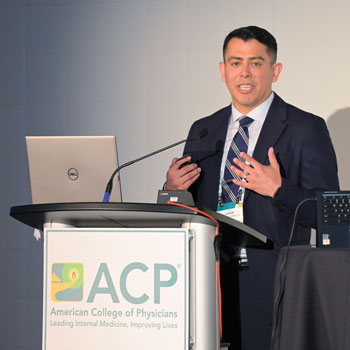Address pain during sex as a normal part of care
Sexual dysfunction can be as routine a part of primary care as diabetes or cardiovascular disease, one expert says.
The concept of sexual pain is something that physicians don't necessarily think of that commonly, because it is a personal issue that oftentimes individuals are concerned about bringing up. Or it's something that, for no good reason, individuals feel shame about, or they feel alone in, and so they feel afraid to bring it up. Unfortunately, many of us have been taught, and are still being taught, that sex should be painful or is expected to be painful at least some of the time. This is something that we as clinicians, especially general internal medicine physicians who see patients across the span of their life, are poised to identify and reeducate patients about. The fact is that sex really shouldn't be painful.
The majority of women who seek health care for a sexual concern will do so from a primary care clinician. If someone has worked up the courage and brings this up to you, please take it seriously, because it is important to them, and it takes a lot of courage to actually bring that up on their own. So please don't dismiss it. A lot of patients still tell me, “I brought this up, and other clinicians have just told me I just need to relax. I'm too anxious, too worried about it.” And so as we approach this, listening to and validating their concerns from the beginning is a huge step in the right direction.
That said, I encourage all clinicians to screen for sexual health concerns regularly, since only about 7% to 10% of the individuals will actually bring it up themselves. People really do prefer the clinician to bring it up and open that door to know that it's a safe place to discuss these personal and intimate topics.
Think about ways to insert the conversation into any visit. We talk about a “ubiquity statement.” Many people with diabetes, many people with neurologic disorders, many people on multiple medications struggle with sexual health. Normalize it so that patients know they are not alone in their concerns. Then, just ask outright, “Are there sexual health concerns you wish to discuss?” Sometimes they'll look at you blankly, and then you can follow up with specifics about arousal, desire, orgasm, pain. Those are the primary domains of sexual function that every health care practitioner should be comfortable knowing about and asking about, even if you're not comfortable ultimately managing the concerns.
Many medications can impact sexual function. Antidepressants are some of those medications that people think about negatively impacting libido and sexual function. However, we also know that depression and anxiety also intimately affect sexual function, and studies show it's much better to treat the anxiety and depression than to have untreated anxiety and depression affecting sexual function. Treating the anxiety and depression and finding the right fit of medication may take a little bit of time, but overall, it's much better for sexual function as a whole.
As we think about sexual pain and the neuroscience of anticipatory pain, when someone has been having sexual pain for a long time, this anticipation of pain upregulates the signaling in the brain, in the insula and the prefrontal cortex, to actually increase the perceived pain. Our body naturally wants to avoid things that are painful. Over time, this creates psychological associations and behavioral modifications, which then negatively impact the sexual response. Pain begets more pain. One of the most important things to reinforce with patients is that we can work through this. We can figure out what's causing this, but please don't keep having painful sex. Please focus on nonpainful, nonpenetrative intimate activities, because it's very difficult to make progress with any sexual pain disorder while we're continuing to reinforce that sexual pain cycle.
As internal medicine physicians, we are those diagnostic specialists. We are able to take these complex patients and, with the history and physical exam, parse out what could be happening and what could be contributing. Taking a really thorough history and doing a physical exam are important key pieces to consider. Evaluate the underlying causes by asking initial questions about, “When did it start? Were you previously able to have pain-free intercourse, or is this something new that's developed over time? What is the timing of pain? What are the provoking factors? Is there pain at rest? Is there pain at other times? Do you have pain with self-stimulation, or is it only with partner penetration? Do you have pain with nonpenetrative sexual activities?”
It's important to be mindful that patients who are having sexual pain are oftentimes very uncomfortable during the physical exam. Giving them permission to stop the exam at any point that they wish is always important to make sure they're comfortable and in control of the situation. Then, start more superficially and work your way to more invasive exam procedures.
First, actually look at the vulva. Look at the skin. Are there skin disorders, vulvar dermatoses, things that you could see on the vulva? Are there areas of irritation? Are there swollen glands? Are there fissures or ulcerations? All of those would be keys to identifying causes of pain. Are there signs of estrogen loss that we oftentimes see with aging?
Genitourinary syndrome of menopause is a very common condition but actually can happen with any low-estrogen state. Oftentimes we forget about people who are lactating or on medications that are blocking estrogen, even though they may not be of menopausal age. And perimenopausal individuals, before they're truly menopausal, can develop symptoms from declining estrogen as well.
Internally, you want to look for obvious concerns of disease at the cervix and the health of the mucosa and the vaginal tissues. Pelvic floor muscles can be frequently involved—and this gets into the chicken and the egg. Are those muscles braced because someone's expecting pain that's been going on for a long time and now they've developed these hypertonic, nonrelaxing muscles? Or were those actually the cause of the pain in the first place? Either way, if they're involved, referring to pelvic floor physical therapy is an important component. Other common etiologies could be endometriosis, pelvic organ prolapse, and more, but the history and physical are going to guide what pieces are more likely to be contributing.
The big things to focus on are screening and identifying it, thinking about the domains of sexual health, and identifying with the history and physical to uncover potential underlying etiologies, and certainly reinforcing that pain should not be normal. Patients don't need to have painful sex. This isn't normal or the expected outcome, and internal medicine physicians can partner with patients to help find solutions if that's something that they want to pursue.



